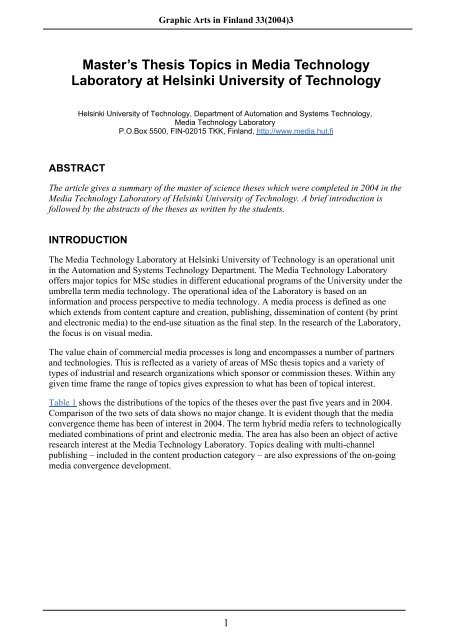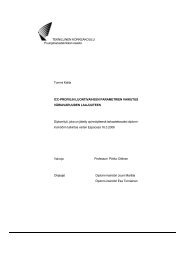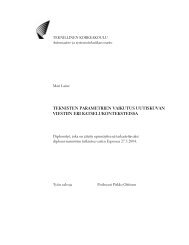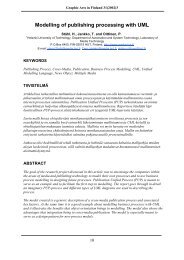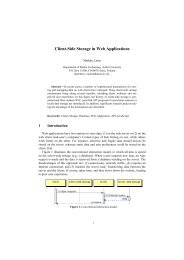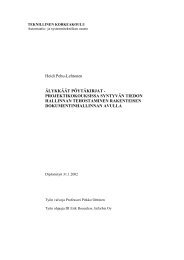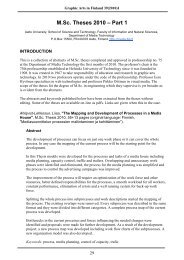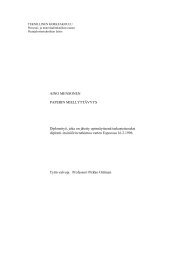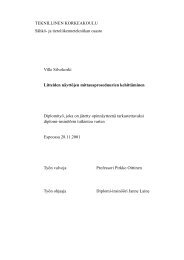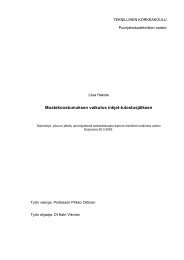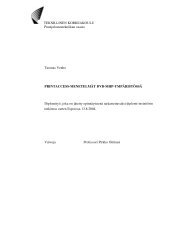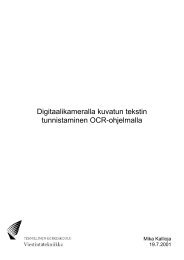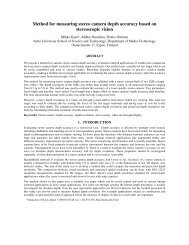Master's Thesis Topics in Media Technology Laboratory at ... - TKK
Master's Thesis Topics in Media Technology Laboratory at ... - TKK
Master's Thesis Topics in Media Technology Laboratory at ... - TKK
You also want an ePaper? Increase the reach of your titles
YUMPU automatically turns print PDFs into web optimized ePapers that Google loves.
Graphic Arts <strong>in</strong> F<strong>in</strong>land 33(2004)3<br />
Master’s <strong>Thesis</strong> <strong>Topics</strong> <strong>in</strong> <strong>Media</strong> <strong>Technology</strong><br />
<strong>Labor<strong>at</strong>ory</strong> <strong>at</strong> Hels<strong>in</strong>ki University of <strong>Technology</strong><br />
Hels<strong>in</strong>ki University of <strong>Technology</strong>, Department of Autom<strong>at</strong>ion and Systems <strong>Technology</strong>,<br />
<strong>Media</strong> <strong>Technology</strong> <strong>Labor<strong>at</strong>ory</strong><br />
P.O.Box 5500, FIN-02015 <strong>TKK</strong>, F<strong>in</strong>land, http://www.media.hut.fi<br />
ABSTRACT<br />
The article gives a summary of the master of science theses which were completed <strong>in</strong> 2004 <strong>in</strong> the<br />
<strong>Media</strong> <strong>Technology</strong> <strong>Labor<strong>at</strong>ory</strong> of Hels<strong>in</strong>ki University of <strong>Technology</strong>. A brief <strong>in</strong>troduction is<br />
followed by the abstracts of the theses as written by the students.<br />
INTRODUCTION<br />
The <strong>Media</strong> <strong>Technology</strong> <strong>Labor<strong>at</strong>ory</strong> <strong>at</strong> Hels<strong>in</strong>ki University of <strong>Technology</strong> is an oper<strong>at</strong>ional unit<br />
<strong>in</strong> the Autom<strong>at</strong>ion and Systems <strong>Technology</strong> Department. The <strong>Media</strong> <strong>Technology</strong> <strong>Labor<strong>at</strong>ory</strong><br />
offers major topics for MSc studies <strong>in</strong> different educ<strong>at</strong>ional programs of the University under the<br />
umbrella term media technology. The oper<strong>at</strong>ional idea of the <strong>Labor<strong>at</strong>ory</strong> is based on an<br />
<strong>in</strong>form<strong>at</strong>ion and process perspective to media technology. A media process is def<strong>in</strong>ed as one<br />
which extends from content capture and cre<strong>at</strong>ion, publish<strong>in</strong>g, dissem<strong>in</strong><strong>at</strong>ion of content (by pr<strong>in</strong>t<br />
and electronic media) to the end-use situ<strong>at</strong>ion as the f<strong>in</strong>al step. In the research of the <strong>Labor<strong>at</strong>ory</strong>,<br />
the focus is on visual media.<br />
The value cha<strong>in</strong> of commercial media processes is long and encompasses a number of partners<br />
and technologies. This is reflected as a variety of areas of MSc thesis topics and a variety of<br />
types of <strong>in</strong>dustrial and research organiz<strong>at</strong>ions which sponsor or commission theses. With<strong>in</strong> any<br />
given time frame the range of topics gives expression to wh<strong>at</strong> has been of topical <strong>in</strong>terest.<br />
Table 1 shows the distributions of the topics of the theses over the past five years and <strong>in</strong> 2004.<br />
Comparison of the two sets of d<strong>at</strong>a shows no major change. It is evident though th<strong>at</strong> the media<br />
convergence theme has been of <strong>in</strong>terest <strong>in</strong> 2004. The term hybrid media refers to technologically<br />
medi<strong>at</strong>ed comb<strong>in</strong><strong>at</strong>ions of pr<strong>in</strong>t and electronic media. The area has also been an object of active<br />
research <strong>in</strong>terest <strong>at</strong> the <strong>Media</strong> <strong>Technology</strong> <strong>Labor<strong>at</strong>ory</strong>. <strong>Topics</strong> deal<strong>in</strong>g with multi-channel<br />
publish<strong>in</strong>g – <strong>in</strong>cluded <strong>in</strong> the content production c<strong>at</strong>egory – are also expressions of the on-go<strong>in</strong>g<br />
media convergence development.<br />
1
Graphic Arts <strong>in</strong> F<strong>in</strong>land 33(2004)3<br />
Table 1<br />
MSc (Eng) thesis topics <strong>in</strong> media technology over a five year period (2000-2004) and<br />
<strong>in</strong> 2004.<br />
Topic<br />
Share, %<br />
2000–2004<br />
n=86<br />
Share, %<br />
2004<br />
n=19<br />
Pr<strong>in</strong>t<strong>in</strong>g 22 21<br />
<strong>Media</strong> process 21 21<br />
Content production 18 10<br />
Interfaces and usability 18 10<br />
Imag<strong>in</strong>g and image process<strong>in</strong>g 9 16<br />
Hybrid media 9 21<br />
Other 3 0<br />
In total 100 100<br />
The follow<strong>in</strong>g table (Table 2) shows th<strong>at</strong> two thirds of the theses have been sponsored or<br />
commissioned by the graphic arts, media, ICT and forest <strong>in</strong>dustries. The distribution fluctu<strong>at</strong>es<br />
from year to year and appears to follow the economical situ<strong>at</strong>ion <strong>in</strong> any given <strong>in</strong>dustry.<br />
Table 2<br />
MSc (Eng) thesis topics <strong>in</strong> media technology over a five year period (2000-2004) and <strong>in</strong><br />
2004. GTTS is the Research Fund for the Graphic Arts Industry.<br />
Sponsored/Commissioned by<br />
Share, %<br />
2000–2004<br />
n=86<br />
Share, %<br />
2004<br />
n=19<br />
Graphic Arts Industry (<strong>in</strong>c. GTTS) 27 26<br />
<strong>Media</strong> Industry 16 10<br />
ICT (<strong>in</strong>c. technology suppliers and<br />
teleoper<strong>at</strong>ors) 21 13<br />
Forest <strong>in</strong>dustry 21 24<br />
Hels<strong>in</strong>ki University of <strong>Technology</strong> 8 17<br />
Other 7 10<br />
In total 100 100<br />
It is evident th<strong>at</strong> the graphic arts and media <strong>in</strong>dustries have been the most active <strong>in</strong> support<strong>in</strong>g<br />
theses.<br />
2
Graphic Arts <strong>in</strong> F<strong>in</strong>land 33(2004)3<br />
THESIS ABSTRACTS<br />
The titles of the theses completed <strong>in</strong> 2004 are listed <strong>in</strong> Table 3.<br />
Table 3 The titles of master’s thesis topics <strong>in</strong> 2004.<br />
Author<br />
Airo, Liisi<br />
Honkkila, Pauli<br />
Hänn<strong>in</strong>en, Maria<br />
Kallenbach, Jan<br />
Kiv<strong>in</strong>en, Jyri<br />
Koivu, Juha<br />
Korp<strong>in</strong>en, Olli<br />
Koskela, Jeremias<br />
La<strong>in</strong>e, Mari<br />
Muttila<strong>in</strong>en, Tero<br />
Nuut<strong>in</strong>en, Mikko<br />
Penttilä, Jopi<br />
R<strong>in</strong>nemaa, Tommi<br />
Ruuhonen, Samu<br />
Räsänen, Pia<br />
Salo, Eeva Leena<br />
Syrjänen, Karoli<strong>in</strong>a<br />
Venho, Tuomas<br />
Westman, St<strong>in</strong>a<br />
Title of the <strong>Thesis</strong><br />
Exploit<strong>at</strong>ion of Paper-reel Specific Inform<strong>at</strong>ion <strong>in</strong> He<strong>at</strong>set-offset<br />
Pr<strong>in</strong>t<strong>in</strong>g<br />
Modell<strong>in</strong>g and Develop<strong>in</strong>g Inform<strong>at</strong>ion Systems of a Production<br />
Plant<br />
The Influence of Screen Size and Resolution on the Effectiveness<br />
and Workload of Read<strong>in</strong>g from Screen <strong>in</strong> Office Work<br />
Design of Concepts for the Pr<strong>in</strong>t <strong>Media</strong>-Based Access to the<br />
DVB/MHP-Environment and Implement<strong>at</strong>ion of a Reference<br />
Applic<strong>at</strong>ion<br />
Development of Face Process<strong>in</strong>g Methods for Content-Based<br />
Image Retrieval<br />
Read<strong>in</strong>g a Pr<strong>in</strong>ted Code With a Camera Phone<br />
Reliability of Teleoper<strong>at</strong>or's IP-network Services<br />
Present<strong>at</strong>ion of F<strong>in</strong>ancial Inform<strong>at</strong>ion <strong>in</strong> Digital Television<br />
Influence of Technical Parameters on the Messages of News<br />
Photographs <strong>in</strong> Different View<strong>in</strong>g Contexts<br />
Modific<strong>at</strong>ion of a Rotogravure Press for Six-around Production<br />
Factors Affect<strong>in</strong>g the Rreadability of Codes Pr<strong>in</strong>ted with Invisible<br />
Inks<br />
Efficiency and Workload of Multiple Display Use <strong>in</strong> Office Work<br />
Synergy of Paper and Onl<strong>in</strong>e Public<strong>at</strong>ions: Development of Weekly<br />
Journal from Readers' Perspective<br />
Visual Inform<strong>at</strong>ion of 3D Objects <strong>in</strong> Real-Time Render<strong>in</strong>g<br />
Detail Render<strong>in</strong>g of Dry Toner Based Digital Electrophotography<br />
Communic<strong>at</strong>ion Practices <strong>in</strong> Project Management – the Rel<strong>at</strong>ion of<br />
<strong>Media</strong> to Message<br />
Visual Colour Sharpness – Influenc<strong>in</strong>g Factors<br />
Pr<strong>in</strong>tAccess Methods <strong>in</strong> the DVB-MHP Environment<br />
The Utiliz<strong>at</strong>ion of Image Selection Knowledge <strong>in</strong> an Editorial<br />
System<br />
The abstracts of the theses are given below <strong>in</strong> alphabetical order of the authors. Some of the<br />
theses are available on-l<strong>in</strong>e, as <strong>in</strong>dic<strong>at</strong>ed by l<strong>in</strong>ks.<br />
Airo, Liisi, Exploit<strong>at</strong>ion of Paper-reel Specific Inform<strong>at</strong>ion <strong>in</strong> He<strong>at</strong>set-offset Pr<strong>in</strong>t<strong>in</strong>g. In<br />
F<strong>in</strong>nish, 89 pages.<br />
The purpose of this master's thesis was to clarify if there is a need to exploit paper-reel specific<br />
<strong>in</strong>form<strong>at</strong>ion on a pr<strong>in</strong>t<strong>in</strong>g mach<strong>in</strong>e. Based on test pr<strong>in</strong>ts, the experimental part aims to def<strong>in</strong>e<br />
wh<strong>at</strong> types of changes <strong>in</strong> the paper cause the colour control system to react, and how quickly the<br />
control system responds to changes <strong>in</strong> the paper.<br />
3
Graphic Arts <strong>in</strong> F<strong>in</strong>land 33(2004)3<br />
The literary part first addresses how the appearance of the typography is produced <strong>in</strong> he<strong>at</strong>setoffset<br />
pr<strong>in</strong>t<strong>in</strong>g. Through liter<strong>at</strong>ure also the pr<strong>in</strong>t<strong>in</strong>g mach<strong>in</strong>e's <strong>in</strong>k<strong>in</strong>g unit mechanism became<br />
familiar, <strong>in</strong> particular the function<strong>in</strong>g and functionality of the ColorQuick colour control system<br />
used <strong>in</strong> the experimental part. The sav<strong>in</strong>g and stor<strong>in</strong>g of the paper-reel specific <strong>in</strong>form<strong>at</strong>ion and<br />
autom<strong>at</strong>ic identific<strong>at</strong>ion of the reels is also addressed.<br />
The usability test of the ColorQuick colour control system, as carried out <strong>in</strong> the experimental<br />
part, shows th<strong>at</strong> the system was experienced as useful and necessary, and no major functionality<br />
problems were reported. The research m<strong>at</strong>erial was g<strong>at</strong>hered by test pr<strong>in</strong>t<strong>in</strong>g collection reels with<br />
a he<strong>at</strong>set-offset pr<strong>in</strong>t<strong>in</strong>g mach<strong>in</strong>e us<strong>in</strong>g the colour control system. Test runs were conducted with<br />
four different collection reels th<strong>at</strong> consisted of paper samples composed of paper of different<br />
qualities. Correl<strong>at</strong>ion coefficients and the t-test were used, when the impact of various properties<br />
to the devi<strong>at</strong>ion dispersion of the densities was tested. Of the researched correl<strong>at</strong>ions, with a 90%<br />
confidence level, there was a st<strong>at</strong>istically mean<strong>in</strong>gful correl<strong>at</strong>ion between the need of colour, the<br />
sh<strong>in</strong>e, evenness, lightness and density level.<br />
Based on the measurements, it could be concluded th<strong>at</strong> the stabilis<strong>at</strong>ion of the colour control<br />
system occurs, after chang<strong>in</strong>g the paper quality, <strong>at</strong> about 1500-1700 meters, <strong>in</strong> other words<br />
approxim<strong>at</strong>ely after 2400-2700 pr<strong>in</strong>ted sheets. When measur<strong>in</strong>g po<strong>in</strong>ts were changed, the<br />
vari<strong>at</strong>ions <strong>in</strong> the density clearly followed the predicted results for the need of colour and the<br />
settl<strong>in</strong>g of the colour. The vari<strong>at</strong>ions were m<strong>in</strong>or when chang<strong>in</strong>g paper samples. When alter<strong>in</strong>g<br />
paper samples, both the manufactur<strong>in</strong>g and the pr<strong>in</strong>t<strong>in</strong>g side of the paper sheets had no<br />
significant impact to the density changes of the sheets pr<strong>in</strong>ted with the colour control system on.<br />
Neither the vari<strong>at</strong>ion <strong>in</strong> the paper quality nor the change <strong>in</strong> the weight of the paper <strong>in</strong> different<br />
paper samples had as significant of an effect on the density values as foreseen. Conclusion<br />
drawn from the test results shows th<strong>at</strong> only a change <strong>in</strong> the paper type had an important enough<br />
impact justify<strong>in</strong>g the use of th<strong>at</strong> <strong>in</strong>form<strong>at</strong>ion on the pr<strong>in</strong>t<strong>in</strong>g mach<strong>in</strong>e. The exploit<strong>at</strong>ion of paperreel<br />
specific or paper-b<strong>at</strong>ch specific <strong>in</strong>form<strong>at</strong>ion on the pr<strong>in</strong>t<strong>in</strong>g mach<strong>in</strong>e is accord<strong>in</strong>g to the<br />
research not beneficial.<br />
Honkkila, Pauli, Modell<strong>in</strong>g and Develop<strong>in</strong>g Inform<strong>at</strong>ion Systems of a Production Plant. In<br />
F<strong>in</strong>nish, 133 pages.<br />
Inform<strong>at</strong>ion systems are an essential part of bus<strong>in</strong>ess oper<strong>at</strong>ions. Develop<strong>in</strong>g these systems too<br />
rapidly results <strong>in</strong> an accumul<strong>at</strong>ion of problems for both the users and the designers of the system.<br />
Modell<strong>in</strong>g <strong>in</strong>form<strong>at</strong>ion systems makes it possible to stop and take stock of the current st<strong>at</strong>us of<br />
such systems and to take an <strong>in</strong>-depth look <strong>at</strong> the real problems <strong>in</strong> this area. The ma<strong>in</strong> objective of<br />
this research is to model the <strong>in</strong>form<strong>at</strong>ion systems of the production plant, which was the subject<br />
of the study, by def<strong>in</strong><strong>in</strong>g a user-centred modell<strong>in</strong>g process. This process has been designed to<br />
suit a situ<strong>at</strong>ion <strong>in</strong> which there are serious weaknesses <strong>in</strong> the modell<strong>in</strong>g and document<strong>at</strong>ion of<br />
<strong>in</strong>form<strong>at</strong>ion systems, and <strong>in</strong> which the results of the modell<strong>in</strong>g process will provide a basis for<br />
improvements to the systems. The most important part of the research m<strong>at</strong>erials studied is<br />
comprised of the system users' contextual <strong>in</strong>terviews. The modell<strong>in</strong>g process embraces<br />
conceptual modell<strong>in</strong>g, use case briefs and activity diagrams of UML modell<strong>in</strong>g, and models<br />
us<strong>in</strong>g d<strong>at</strong>a-flow diagrams. In addition, the study discusses the evalu<strong>at</strong>ion and usability of<br />
<strong>in</strong>form<strong>at</strong>ion systems as well as suggestions for the improvement of these systems on the basis of<br />
the modell<strong>in</strong>g process.<br />
4
Graphic Arts <strong>in</strong> F<strong>in</strong>land 33(2004)3<br />
Hänn<strong>in</strong>en, Maria, The Influence of Screen Size and Resolution on the Effectiveness and<br />
Workload of Read<strong>in</strong>g from Screen <strong>in</strong> Office Work (PDF: Näyttöp<strong>in</strong>ta-alan ja resoluution<br />
vaikutukset näytöltä lukemisen tehokkuuteen ja kuormittavuuteen toimistotyössä). In F<strong>in</strong>nish, 74<br />
+ 27 pages.<br />
The purpose of this master’s thesis was to determ<strong>in</strong>e whether wide-angle or veryhigh-resolution<br />
screens enabl<strong>in</strong>g more efficient use of peripheral vision have any advantage over smaller or<br />
lower resolution screens when screens are used for read<strong>in</strong>g large documents <strong>in</strong> an office<br />
environment. At the same time, <strong>in</strong>terest was taken <strong>in</strong> if <strong>in</strong>creased visual <strong>in</strong>form<strong>at</strong>ion provided by<br />
higher resolution required more mental workload or if the amount of workload was dim<strong>in</strong>ished<br />
because of <strong>in</strong>creased context <strong>in</strong>form<strong>at</strong>ion or clearer text.<br />
The liter<strong>at</strong>ure part dealt with human visual system and knowledge of read<strong>in</strong>g, especially read<strong>in</strong>g<br />
from screens. The concept of mental workload and methods for estim<strong>at</strong><strong>in</strong>g it were also<br />
discussed.<br />
The experimental part conta<strong>in</strong>ed experiments run on a 22,2” 16:10-r<strong>at</strong>io LCD-screen with<br />
maximum resolution of 204 dpi. Tests <strong>in</strong>cluded three different layouts us<strong>in</strong>g wider visual angle<br />
and one test us<strong>in</strong>g narrower visual angle. The <strong>in</strong>fluence of resolution was also tested. The<br />
performance was measured by read<strong>in</strong>g r<strong>at</strong>e, read<strong>in</strong>g comprehension and read<strong>in</strong>g efficiency.<br />
Workload was measured by subjective estim<strong>at</strong>e calcul<strong>at</strong>ed by NASA Task Load Index and<br />
physiological estim<strong>at</strong>es measured by eye bl<strong>in</strong>k r<strong>at</strong>e and heart r<strong>at</strong>e variability. The subjects also<br />
answered a question about the most pleasant way of display<strong>in</strong>g text on screen and <strong>in</strong> wh<strong>at</strong> way<br />
they could see themselves us<strong>in</strong>g the test display for read<strong>in</strong>g <strong>in</strong> everyday use.<br />
The experiments showed no st<strong>at</strong>istically significant effects of the way the text was represented<br />
on the screen on read<strong>in</strong>g performance or on mental workload. Read<strong>in</strong>g comprehension was<br />
slightly improved when text represent<strong>at</strong>ion was larger <strong>in</strong> peripheral visual field. Improv<strong>in</strong>g<br />
resolution reduced workload measured by both subjective r<strong>at</strong><strong>in</strong>gs and heart r<strong>at</strong>e variability<br />
st<strong>at</strong>istically significantly.<br />
Kallenbach, Jan, Design of Concepts for the Pr<strong>in</strong>t <strong>Media</strong>-Based Access to the DVB/MHP-<br />
Environment and Implement<strong>at</strong>ion of a Reference Applic<strong>at</strong>ion. In English, 165 pages.<br />
Digital media, like the Internet, have changed the lives of our society quite quickly. Their<br />
<strong>in</strong>creas<strong>in</strong>g use contrasts the decreas<strong>in</strong>g acceptance of analogue media like newspapers. The<br />
“Pr<strong>in</strong>tAccess” project <strong>at</strong> Hels<strong>in</strong>ki University of <strong>Technology</strong> has the goal to better the<br />
<strong>at</strong>tractiveness of pr<strong>in</strong>t media towards electronic media. The exchange of <strong>in</strong>form<strong>at</strong>ion is thereby<br />
centric and achieved by <strong>in</strong>troduc<strong>in</strong>g “Pr<strong>in</strong>tAccess” codes. Read by today’s available mobile<br />
devices they provide access from pr<strong>in</strong>t media to electronic media and allow therefore pr<strong>in</strong>t-based<br />
<strong>in</strong>teractive communic<strong>at</strong>ion.<br />
The aim of this thesis, as a part of the “Pr<strong>in</strong>tAccess” project, is the cre<strong>at</strong>ion of detailed<br />
conceptual and technological models, which consider rel<strong>at</strong>ions between pr<strong>in</strong>t media products and<br />
the digital television system. The research of the RFID technology and the reception of digital<br />
television on mobile devices gives an <strong>in</strong>sight to the technological possibilities. It is expectable<br />
th<strong>at</strong> the <strong>in</strong>terest <strong>in</strong> the developed concepts will <strong>in</strong>crease dur<strong>in</strong>g the last years. Therefore, a survey<br />
among several organiz<strong>at</strong>ions work<strong>in</strong>g <strong>in</strong> the pr<strong>in</strong>t and broadcast <strong>in</strong>dustry is done to f<strong>in</strong>d out<br />
possible future developments regard<strong>in</strong>g pr<strong>in</strong>t-based <strong>in</strong>teractive communic<strong>at</strong>ion. F<strong>in</strong>ally a<br />
reference applic<strong>at</strong>ion will demonstr<strong>at</strong>e the prototypical functionality of one concept. Thereby<br />
one goal is to realize the connection of today’s available small RFID reader components with<br />
mobile devices to read <strong>in</strong> smart tags, which can be <strong>at</strong>tached or <strong>in</strong>tegr<strong>at</strong>ed to any k<strong>in</strong>d of pr<strong>in</strong>t<br />
5
Graphic Arts <strong>in</strong> F<strong>in</strong>land 33(2004)3<br />
product. A second goal is the implement<strong>at</strong>ion of user <strong>in</strong>terface to demonstr<strong>at</strong>e the usability of<br />
mobile devices regard<strong>in</strong>g the reception of digital television.<br />
Kiv<strong>in</strong>en, Jyri, Development of Face Process<strong>in</strong>g Methods for Content-Based Image Retrieval.<br />
In English, 116 pages.<br />
In this thesis it is studied the tasks of face localiz<strong>at</strong>ion and pose estim<strong>at</strong>ion from digital color<br />
images of which each conta<strong>in</strong>s a s<strong>in</strong>gle person. Inform<strong>at</strong>ion obta<strong>in</strong>ed from the completion of the<br />
tasks is <strong>in</strong>tended to be used <strong>in</strong> estim<strong>at</strong><strong>in</strong>g semantic criteria def<strong>in</strong>ed by an ontogy for contentbased<br />
image retrieval. The ontology has been developed earlier <strong>in</strong> the <strong>Labor<strong>at</strong>ory</strong> of <strong>Media</strong><br />
<strong>Technology</strong>.<br />
The theoretical part of the thesis consists of liter<strong>at</strong>ure reviews on face localiz<strong>at</strong>ion and pose<br />
estim<strong>at</strong>ion. It is concentr<strong>at</strong>ed on most recent and suitable methods for the tasks <strong>at</strong> hand.<br />
The practical part of the thesis was the development and implement<strong>at</strong>ion and test<strong>in</strong>g of the<br />
methods. The face process<strong>in</strong>g <strong>in</strong> the methods consists of two larger stages. The task of the<br />
methods <strong>in</strong> the first stage is to loc<strong>at</strong>e the face and estim<strong>at</strong>e its pose with such precision, th<strong>at</strong> the<br />
methods <strong>in</strong> the second stage can be used. The first stage uses control str<strong>at</strong>egies <strong>in</strong> case of some<br />
failures <strong>in</strong> the localiz<strong>at</strong>ion process. The second stage tries to improve the results of the first<br />
stage.<br />
The coarse stage <strong>in</strong>cludes face region, eyes and mouth localiz<strong>at</strong>ion. The face region search<br />
<strong>in</strong>cludes us<strong>in</strong>g sk<strong>in</strong> detection by adaptive threshold<strong>in</strong>g. The face region <strong>in</strong> more detail and eyes<br />
are loc<strong>at</strong>ed with loc<strong>at</strong>ors, th<strong>at</strong> are based on the Viola-Jones face detector. The localiz<strong>at</strong>ion of the<br />
mouth is based on us<strong>in</strong>g multiple fe<strong>at</strong>ures and cues such as <strong>in</strong>form<strong>at</strong>ion drawn from a mean face<br />
model, loc<strong>at</strong>ions of the detected facial fe<strong>at</strong>ures and the results of color-based segment<strong>at</strong>ion. The<br />
pose classific<strong>at</strong>ion th<strong>at</strong> is done <strong>in</strong> the first stage is based on us<strong>in</strong>g a comb<strong>in</strong><strong>at</strong>ion of two<br />
geometric-transform<strong>at</strong>ion based methods and a fe<strong>at</strong>ure-based approach.<br />
The second stage or the ref<strong>in</strong>ement stage is based on us<strong>in</strong>g a face Active Shape Model (ASM).<br />
The face ASM is <strong>in</strong>itialized based on the loc<strong>at</strong>ions of the detected facial fe<strong>at</strong>ure po<strong>in</strong>ts and the<br />
estim<strong>at</strong>ed head turn <strong>in</strong> the coarse stage. The estim<strong>at</strong>ion of the head turn <strong>in</strong> the f<strong>in</strong>al stage is based<br />
on us<strong>in</strong>g the shape parameters of the converged face ASM.<br />
The implemented and developed methods were tested with two different test sets. Various<br />
valid<strong>at</strong>ion measures were used <strong>in</strong> the tests. Despite of the fact th<strong>at</strong> many compromises had to be<br />
made <strong>in</strong> the development and implement<strong>at</strong>ion of the methods due to the comput<strong>at</strong>ional<br />
requirements and partially little tra<strong>in</strong><strong>in</strong>g d<strong>at</strong>a, some very good results have been obta<strong>in</strong>ed.<br />
Koivu, Juha, Read<strong>in</strong>g a Pr<strong>in</strong>ted Code with a Camera Phone (PDF: Pa<strong>in</strong>etun kood<strong>in</strong><br />
lukem<strong>in</strong>en kamerapuhelimella). In F<strong>in</strong>nish,106 pages.<br />
The object of the master’s thesis was to study wh<strong>at</strong> k<strong>in</strong>d of pr<strong>in</strong>ted codes can be read us<strong>in</strong>g a<br />
digital camera. Especially the applicability of mobile devices for the use <strong>in</strong> question was studied.<br />
In order to make the users’ experience of read<strong>in</strong>g pr<strong>in</strong>ted codes useful and appeal<strong>in</strong>g,<br />
applic<strong>at</strong>ions have to provide a high-level of usability. One of the most important factors of<br />
usability is readability, which is exam<strong>in</strong>ed <strong>in</strong> this research.<br />
Different k<strong>in</strong>d of methods to read pr<strong>in</strong>ted codes us<strong>in</strong>g a digital camera were explored. Applicable<br />
methods <strong>in</strong>clude bar codes and m<strong>at</strong>rix codes which are used to encode d<strong>at</strong>a <strong>in</strong> bi-level symbols.<br />
More sophistic<strong>at</strong>ed methods also exist but the performance of present-day mobile devices is<br />
6
Graphic Arts <strong>in</strong> F<strong>in</strong>land 33(2004)3<br />
<strong>in</strong>sufficient to process them. The low quality of the cameras <strong>in</strong> these devices <strong>in</strong>troduces<br />
technological challenges which have to be addressed <strong>in</strong> order to achieve good usability.<br />
Readability of various symbol types was studied <strong>in</strong> the empirical portion of this research. In<br />
addition the imag<strong>in</strong>g quality and properties of cameraphones were compared to digital cameras<br />
of good quality consider<strong>in</strong>g future possibilities. The tests measured the effect of symbol type,<br />
quality of the camera and imag<strong>in</strong>g properties. The variables used were camera resolution, image<br />
compression r<strong>at</strong>io, imag<strong>in</strong>g distance and angle as well as focal distance of the lens. In addition<br />
the effect of symbol type, amount of encoded d<strong>at</strong>a and symbol size were studied. Especially the<br />
close focus<strong>in</strong>g ability of the lens and imag<strong>in</strong>g resolution had strong <strong>in</strong>fluence on readability. The<br />
readability of both bar codes and m<strong>at</strong>rix codes was reasonable but the vers<strong>at</strong>ility of m<strong>at</strong>rix codes<br />
is better suited for this k<strong>in</strong>d of use.<br />
Read<strong>in</strong>g of pr<strong>in</strong>ted codes is possible with present-day mobile devices on the basis of these<br />
measurements. However usability is limited by low d<strong>at</strong>a process<strong>in</strong>g power, poor close focus<strong>in</strong>g<br />
ability and low resolution of cameras. As technical properties improve smaller and more<br />
complex codes can be read more easily and reliably.<br />
Korp<strong>in</strong>en, Olli, Reliability of Teleoper<strong>at</strong>or's IP-network Services. In F<strong>in</strong>nish, 64 pages.<br />
The importance of communic<strong>at</strong>ion networks <strong>in</strong> everyday communic<strong>at</strong>ions and bus<strong>in</strong>ess life has<br />
<strong>in</strong>creased significantly dur<strong>in</strong>g the past decades. At the same time requirements for service<br />
capacity and reliability have <strong>in</strong>creased as well.<br />
The scope of this <strong>Master's</strong> thesis is to evalu<strong>at</strong>e a given teleoper<strong>at</strong>or's IP-network services<br />
reliability with vary<strong>in</strong>g d<strong>at</strong>a l<strong>in</strong>k layer technologies. The literary part <strong>in</strong>troduces different<br />
technologies and oper<strong>at</strong>or's correspond<strong>in</strong>g services with their ma<strong>in</strong> components. Also the core<br />
elements of SLA :s are <strong>in</strong>troduced. The work part evalu<strong>at</strong>es the actual realis<strong>at</strong>ion of the service<br />
reliability compared to the SLA provided. The r<strong>at</strong>io between realised values and S LA is<br />
analysed and sanction probabilities predicted.<br />
As an outcome the current st<strong>at</strong>e of the service can be evalu<strong>at</strong>ed. Development needs <strong>in</strong> the<br />
service, reliability measurement tools and subcontractor rel<strong>at</strong>ions are po<strong>in</strong>ted out.<br />
The key figures and st<strong>at</strong>istics of this thesis conta<strong>in</strong> deliber<strong>at</strong>e <strong>in</strong>accuracy. No additional<br />
conclusions of the teleoper<strong>at</strong>or or the service can be done, but the ones mentioned with<strong>in</strong> this<br />
thesis.<br />
Koskela, Jeremias, Present<strong>at</strong>ion of F<strong>in</strong>ancial Inform<strong>at</strong>ion <strong>in</strong> Digital Television. In F<strong>in</strong>nish,<br />
82 pages.<br />
It has been known from the start of digital television broadcast<strong>in</strong>g <strong>in</strong> F<strong>in</strong>land 2001 th<strong>at</strong> the most<br />
<strong>in</strong>terest<strong>in</strong>g area of this new technology is the new <strong>in</strong>teractive services. MHP-pl<strong>at</strong>form which is<br />
based on Java technology makes it possible to produce for example two-way bank or<br />
communic<strong>at</strong>ion services to the television.<br />
The goal of this research was to <strong>in</strong>vestig<strong>at</strong>e how f<strong>in</strong>ancial <strong>in</strong>form<strong>at</strong>ion and news can be presented<br />
<strong>in</strong> digital television. On the basis of tests carried out <strong>in</strong> test environment specifically built for this<br />
project and the liter<strong>at</strong>ure study, the new service was decided to cre<strong>at</strong>e <strong>in</strong>to Superteletext<br />
environment without the use of return-channel. Superteletext service is a new version of analog<br />
teletext service. Pictures, graphic, hyperl<strong>in</strong>ks and other media objects can now be used. Better<br />
7
Graphic Arts <strong>in</strong> F<strong>in</strong>land 33(2004)3<br />
graphic environment and page description language makes it easy to produce content to the<br />
Superteletext. Exist<strong>in</strong>g Internet services were used as a base for design<strong>in</strong>g content to the service.<br />
Research st<strong>at</strong>ed th<strong>at</strong> the technology of normal CTR-television guides how the service will shape<br />
<strong>in</strong>to the television. For example flicker<strong>in</strong>g and colors must be considered thoroughly. The<br />
aspects of us<strong>in</strong>g remote controller has to be also taken <strong>in</strong>to account when design<strong>in</strong>g the<br />
navig<strong>at</strong>ion and usability of the service.<br />
In the end of the study a new f<strong>in</strong>ancial <strong>in</strong>form<strong>at</strong>ion service was cre<strong>at</strong>ed accord<strong>in</strong>g to the results.<br />
La<strong>in</strong>e, Mari, Influence of Technical Parameters on the Messages of News Photographs <strong>in</strong><br />
Different View<strong>in</strong>g Contexts. In F<strong>in</strong>nish, 125 pages.<br />
The goal of this Master’s <strong>Thesis</strong> was to <strong>in</strong>vestig<strong>at</strong>e the <strong>in</strong>fluence of different technical<br />
parameters on the messages of news photographs <strong>in</strong> different view<strong>in</strong>g contexts. The technical<br />
parameters <strong>in</strong>cluded color brightness, contrast and s<strong>at</strong>ur<strong>at</strong>ion, image size, cropp<strong>in</strong>g and<br />
sharpness. Different view<strong>in</strong>g contexts occur for example while read<strong>in</strong>g a newspaper.<br />
Photographs can be glanced <strong>at</strong> very quickly, they can be viewed <strong>in</strong> a more concentr<strong>at</strong>ed manner,<br />
or they can be present <strong>in</strong> the peripheral visual field. The research concentr<strong>at</strong>ed on still news<br />
photographs <strong>in</strong>clud<strong>in</strong>g people as subjects.<br />
The liter<strong>at</strong>ure survey discussed the messages of images, news photographs and different<br />
technical parameters based on liter<strong>at</strong>ure ma<strong>in</strong>ly <strong>in</strong> the fields of communic<strong>at</strong>ion, visual<br />
communic<strong>at</strong>ion and photojournalism. The perceptual process of view<strong>in</strong>g images and different<br />
view<strong>in</strong>g contexts were discussed based on liter<strong>at</strong>ure <strong>in</strong> perceptual and cognitive psychology.<br />
Two experiments were conducted <strong>in</strong> order to study the <strong>in</strong>fluence of technical parameters on the<br />
messages of news photographs. The participants were randomly divided <strong>in</strong>to two groups of<br />
subjects. Each photograph was digitally manipul<strong>at</strong>ed <strong>in</strong> terms of a s<strong>in</strong>gle parameter and different<br />
versions of the same photograph were presented to the groups. In the first experiment subjects<br />
evalu<strong>at</strong>ed the photographs by choos<strong>in</strong>g their visually most salient element (e.g. a person or an<br />
object) after a rapid present<strong>at</strong>ion of the photograph and the most important element after view<strong>in</strong>g<br />
the photograph freely without a time limit. In the second experiment photographs were presented<br />
<strong>in</strong> the subjects’ peripheral visual field. The subjects chose their visually most salient elements,<br />
described the photographs verbally and judged their impression of the photographs us<strong>in</strong>g bipolar<br />
adjectives.<br />
The technical parameters generally had more <strong>in</strong>fluence on the visual salience of elements than<br />
on their importance. Adjustments of s<strong>at</strong>ur<strong>at</strong>ion, cropp<strong>in</strong>g and sharpness generally <strong>in</strong>fluenced an<br />
element’s salience or importance the most. When the photographs were seen <strong>in</strong> the peripheral<br />
visual field, s<strong>at</strong>ur<strong>at</strong>ion had the most <strong>in</strong>fluence on the salience of elements and the subjects’<br />
impressions of the photographs.<br />
Muttila<strong>in</strong>en, Tero, Modific<strong>at</strong>ion of a Rotogravure Press for Six-around Production. In<br />
F<strong>in</strong>nish, 94 + 13 pages.<br />
The thesis was made on assignment by a pr<strong>in</strong>t<strong>in</strong>g house th<strong>at</strong> recently acquired a second<br />
rotogravure press. The purpose of the thesis was to <strong>in</strong>vestig<strong>at</strong>e the technical modific<strong>at</strong>ions<br />
required and the cost for modify<strong>in</strong>g this press to six-around production. Six-around production <strong>in</strong><br />
rotogravure pr<strong>in</strong>t<strong>in</strong>g means there are six pr<strong>in</strong>ted pages positioned around the gravure cyl<strong>in</strong>der<br />
<strong>in</strong>stead of the normal four, which is known as four-around production. The number of pages th<strong>at</strong><br />
8
Graphic Arts <strong>in</strong> F<strong>in</strong>land 33(2004)3<br />
can be pr<strong>in</strong>ted <strong>at</strong> the same time with six-around production <strong>in</strong>creases by half <strong>in</strong> comparison to<br />
four-around production.<br />
The effects of six-around production on efficiency of rotogravure production were also<br />
<strong>in</strong>vestig<strong>at</strong>ed and the profitability of the <strong>in</strong>vestment was evalu<strong>at</strong>ed. A simul<strong>at</strong>ion model of the<br />
rotogravure production system was constructed to estim<strong>at</strong>e and evalu<strong>at</strong>e the effects of six-around<br />
production on production efficiency. A simul<strong>at</strong>ion of the production of a large-circul<strong>at</strong>ion<br />
magaz<strong>in</strong>e with large number of pages was run. The performance measures selected for<br />
evalu<strong>at</strong>ion were the turnaround time and work <strong>in</strong> process. The cost effects were evalu<strong>at</strong>ed on the<br />
basis of production times on each production mach<strong>in</strong>e. Also, the importance of proper project<br />
management for successful <strong>in</strong>vestment projects was studied.<br />
The result of the thesis is the description of the different altern<strong>at</strong>ives for mov<strong>in</strong>g to six-around<br />
production. Modific<strong>at</strong>ion of the pr<strong>in</strong>t<strong>in</strong>g units, the folder and the cyl<strong>in</strong>der mak<strong>in</strong>g equipment are<br />
required. Instead of modific<strong>at</strong>ion of the old equipment, the cyl<strong>in</strong>der mak<strong>in</strong>g equipment can also<br />
be replaced and renewed, completely or <strong>in</strong> part.<br />
Based on the simul<strong>at</strong>ion results and the current production of the pr<strong>in</strong>t<strong>in</strong>g house <strong>in</strong> question,<br />
mov<strong>in</strong>g on to six-around production would be a profitable <strong>in</strong>vestment. It would significantly<br />
boost efficiency and cut costs <strong>in</strong> certa<strong>in</strong> production situ<strong>at</strong>ions. The thesis also conta<strong>in</strong>s a<br />
suggested actions needed and a prelim<strong>in</strong>ary project plan for mov<strong>in</strong>g on to six-around production.<br />
Nuut<strong>in</strong>en, Mikko, Factors Affect<strong>in</strong>g the Readability of Codes Pr<strong>in</strong>ted with Invisible Inks. In<br />
F<strong>in</strong>nish, 94 pages.<br />
The object of this study was to f<strong>in</strong>d out the factors th<strong>at</strong> affect read<strong>in</strong>g <strong>in</strong>visible codes. In the<br />
study 2-dimensional D<strong>at</strong>a-M<strong>at</strong>rix codes were pr<strong>in</strong>ted us<strong>in</strong>g <strong>in</strong>ks th<strong>at</strong> were <strong>in</strong>visible without<br />
ultraviolet radi<strong>at</strong>ion. With pr<strong>in</strong>ted codes it is possible to enhance the synergy between pr<strong>in</strong>ted<br />
media and a mobile device with camera. With visible codes there are restrictions for size and<br />
alignment of the codes. They could also be esthetically disturb<strong>in</strong>g. These problems could be<br />
removed or reduced by us<strong>in</strong>g <strong>in</strong>visible codes.<br />
In the liter<strong>at</strong>ure part of this study different phases th<strong>at</strong> affect the imag<strong>in</strong>g process of the codes<br />
were studied. In the imag<strong>in</strong>g process the affect<strong>in</strong>g factors are light sources and properties of<br />
imag<strong>in</strong>g object and read<strong>in</strong>g device. In the empirical part of this study light<strong>in</strong>g and different<br />
properties of the pr<strong>in</strong>t carrier were studied. In addition alignment of codes on the pr<strong>in</strong>t carrier<br />
was studied. The 2-dimensional D<strong>at</strong>a-M<strong>at</strong>rix codes were pr<strong>in</strong>ted with different <strong>in</strong>ks to different<br />
paper types. In additition different colors and figures, like text and l<strong>in</strong>es, were used. Present-day<br />
mobile camera phone or sophistic<strong>at</strong>ed digital camera were used as imag<strong>in</strong>g devices. After th<strong>at</strong><br />
imaged pictures were <strong>in</strong>put to the computer based decoder.<br />
The results showed th<strong>at</strong> read<strong>in</strong>g codes, which are pr<strong>in</strong>ted with fluorescence <strong>in</strong>k, require th<strong>at</strong><br />
emission of the <strong>in</strong>k is high enough compared to the emission of the paper. Emission of the <strong>in</strong>k<br />
depends highly on the paper types. It was possible to read codes th<strong>at</strong> were pr<strong>in</strong>ted over a th<strong>in</strong> l<strong>in</strong>e<br />
or certa<strong>in</strong> colour or onto a blank surface when degree of success was set to 90 %. Read<strong>in</strong>g<br />
performance reduces significantly if light<strong>in</strong>g also <strong>in</strong>clude visible light. Read<strong>in</strong>g was impossible<br />
when codes were pr<strong>in</strong>ted over text. It is possible to read codes th<strong>at</strong> are pr<strong>in</strong>ted with fluorescence<br />
<strong>in</strong>k, but it requires careful applic<strong>at</strong>ion specific plann<strong>in</strong>g.<br />
9
Graphic Arts <strong>in</strong> F<strong>in</strong>land 33(2004)3<br />
Penttilä, Jopi, Efficiency and Workload of Multiple Display Use <strong>in</strong> Office Work. In F<strong>in</strong>nish,<br />
57 + 4 pages.<br />
Due to developments <strong>in</strong> display technology and software, it is now possible to use a large display<br />
area <strong>in</strong> conventional office work. A large display area can be achieved either with one big<br />
display or by connect<strong>in</strong>g several small displays. A large display area can conta<strong>in</strong> a lot of<br />
<strong>in</strong>form<strong>at</strong>ion, which has the potential of improv<strong>in</strong>g efficiency. On the other hand, the higher<br />
amount of <strong>in</strong>form<strong>at</strong>ion and unfamiliar display comb<strong>in</strong><strong>at</strong>ions can be more demand<strong>in</strong>g mentally<br />
and therefore decrease efficiency.<br />
This thesis studied the suitability of different display comb<strong>in</strong><strong>at</strong>ions for office work. It<br />
<strong>in</strong>vestig<strong>at</strong>ed the different ways of us<strong>in</strong>g a large display area through literary research and<br />
<strong>in</strong>terviews. In the experimental part of the thesis different k<strong>in</strong>ds of display comb<strong>in</strong><strong>at</strong>ions were<br />
formed. Voluntary test subjects carried out simul<strong>at</strong>ed office tasks us<strong>in</strong>g the display<br />
comb<strong>in</strong><strong>at</strong>ions. Subjective and objective methods were used to study the rel<strong>at</strong>ion between the<br />
display comb<strong>in</strong><strong>at</strong>ion and efficiency and mental workload.<br />
Accord<strong>in</strong>g to the <strong>in</strong>terviews, us<strong>in</strong>g a comb<strong>in</strong><strong>at</strong>ion of two regular displays was both practical and<br />
efficient. With this comb<strong>in</strong><strong>at</strong>ion, one display was clearly the ma<strong>in</strong> one and the other display was<br />
used for supportive or secondary work. The labor<strong>at</strong>ory research supported these results.<br />
Unfamiliar display comb<strong>in</strong><strong>at</strong>ions proved to be less efficient and caused more mental workload.<br />
R<strong>in</strong>nemaa, Tommi, Synergy of Paper and Onl<strong>in</strong>e Public<strong>at</strong>ions: Development of Weekly<br />
Journal from Readers' Perspective. In F<strong>in</strong>nish, 91 pages.<br />
Digital publish<strong>in</strong>g methods and especially web environment have strongly affected the bus<strong>in</strong>ess<br />
of public<strong>at</strong>ion companies. At the same time these companies have adjusted their bus<strong>in</strong>ess<br />
processes to meet the demands of the chang<strong>in</strong>g competition environment.<br />
The development processes of the publish<strong>in</strong>g methods and the competition environment br<strong>in</strong>g<br />
not only thre<strong>at</strong>s but also opportunities for public<strong>at</strong>ions. This research focused on these<br />
possibilities and cre<strong>at</strong>ed an improved journal concept from readers' perspective. Two F<strong>in</strong>nish<br />
weekly joumals were <strong>in</strong>cluded <strong>in</strong> the research.<br />
Qualit<strong>at</strong>ive <strong>in</strong>terviews, expert op<strong>in</strong>ions and aspects from other sources were comb<strong>in</strong>ed to solve<br />
the research problem. In addition, some aspects were verified us<strong>in</strong>g quantit<strong>at</strong>ive <strong>in</strong>terviews. The<br />
development phases of press and onl<strong>in</strong>e publish<strong>in</strong>g were l<strong>in</strong>ked with topics rel<strong>at</strong>ed to<br />
bidirectional functions of the journal concept, <strong>in</strong>teractive fe<strong>at</strong>ures, journalistic style and<br />
f<strong>in</strong>anc<strong>in</strong>g of the public<strong>at</strong>ion. The journal concept consisted of weekly paper, web site and daily<br />
email newsletter.<br />
The research found a l<strong>in</strong>k between read<strong>in</strong>g conditions and the characteristics of the article. It was<br />
concluded th<strong>at</strong> the paper, web site and the email newsletter should be utilized <strong>in</strong> a way th<strong>at</strong> takes<br />
<strong>in</strong>to account different roles of the readers. In this research two ma<strong>in</strong> roles – bus<strong>in</strong>ess role and<br />
leisure role – were po<strong>in</strong>ted out for readers work<strong>in</strong>g either as <strong>in</strong>form<strong>at</strong>ion technology experts or as<br />
directors. Especially time constra<strong>in</strong>ts were concluded to have a high importance <strong>in</strong> bus<strong>in</strong>ess role.<br />
This led to conclusion th<strong>at</strong> rel<strong>at</strong>ively short news stories and unidirectional oper<strong>at</strong><strong>in</strong>g model are<br />
important elements even if <strong>in</strong>teractivity and bidirectional model should be emphasized <strong>in</strong> the<br />
whole journal concept.<br />
10
Graphic Arts <strong>in</strong> F<strong>in</strong>land 33(2004)3<br />
Ruuhonen, Samu, Visual Inform<strong>at</strong>ion of 3D Objects <strong>in</strong> Real-Time Render<strong>in</strong>g. In English, 62<br />
pages.<br />
The purpose of the thesis was to study methods of add<strong>in</strong>g visual <strong>in</strong>form<strong>at</strong>ion <strong>in</strong>to Tekla<br />
Structures, which is structural build<strong>in</strong>g <strong>in</strong>form<strong>at</strong>ion model<strong>in</strong>g (BIM) system made by Tekla<br />
Corpor<strong>at</strong>ion, and possibly implement some of them. At the time, only some colors and light<strong>in</strong>g<br />
were used to separ<strong>at</strong>e different m<strong>at</strong>erials of 3D objects from each other, when view<strong>in</strong>g the<br />
structural model <strong>in</strong> a computer screen.<br />
The author of this thesis had some previous knowledge about real-time render<strong>in</strong>g and based on<br />
th<strong>at</strong> some advanced 3D graphics techniques were studied and tested with simple self-made<br />
test<strong>in</strong>g software. These techniques <strong>in</strong>cluded 2D textur<strong>in</strong>g, texture projector functions, bump<br />
mapp<strong>in</strong>g, procedural textur<strong>in</strong>g, shad<strong>in</strong>g languages and anti-alias<strong>in</strong>g.<br />
Based on research and test<strong>in</strong>g, the 2D textur<strong>in</strong>g support was implemented <strong>in</strong>to Tekla Z-kit,<br />
which is a 3D graphics software library used by Tekla Structures. M<strong>at</strong>erial and light<strong>in</strong>g editors<br />
were also cre<strong>at</strong>ed to make the use of Z-kit easier. In the future, the purpose is to take some<br />
shad<strong>in</strong>g language <strong>in</strong> use, and study wh<strong>at</strong> other 3D techniques mentioned <strong>in</strong> this thesis could and<br />
should be implemented.<br />
Räsänen, Pia, Detail Render<strong>in</strong>g of Dry Toner Based Digital Electrophotography (PDF:<br />
Yksityiskohtien toistokyky pulveritooneripohjaisessa digitaalisessa elektrofotografiassa). In<br />
F<strong>in</strong>nish, 108 pages.<br />
The objective of this research was to def<strong>in</strong>e the current level of detail render<strong>in</strong>g of digital<br />
pr<strong>in</strong>t<strong>in</strong>g presses based on electrophotography by collect<strong>in</strong>g samples pr<strong>in</strong>ted by commercial<br />
digital presses. For the study, electrophotographic office pr<strong>in</strong>ters were selected as a reference.<br />
From the pr<strong>in</strong>ted samples various pr<strong>in</strong>t quality measures were determ<strong>in</strong>ed <strong>in</strong> order to f<strong>in</strong>d out the<br />
factors affect<strong>in</strong>g detail render<strong>in</strong>g <strong>in</strong> electrophotography. In this study only dry toner based<br />
electrophotography was considered.<br />
In the liter<strong>at</strong>ure survey electrophotographic process, factors affect<strong>in</strong>g electrophotographic pr<strong>in</strong>t<br />
quality and measurement of pr<strong>in</strong>t quality were discussed. Accord<strong>in</strong>g to the liter<strong>at</strong>ure detail<br />
render<strong>in</strong>g is affected for example by spread<strong>in</strong>g of the charge p<strong>at</strong>tern on photoconductor, toner<br />
particle size, edge noise and dot spread<strong>in</strong>g.<br />
Samples for the experimental part were g<strong>at</strong>hered by pr<strong>in</strong>t<strong>in</strong>g a test image designed for this study<br />
us<strong>in</strong>g three office pr<strong>in</strong>ters and five digital pr<strong>in</strong>t<strong>in</strong>g presses. The effect of paper on pr<strong>in</strong>t quality<br />
was beyond the scope of this study. Thus, the samples were pr<strong>in</strong>ted only on one paper grade.<br />
Detail render<strong>in</strong>g was studied us<strong>in</strong>g microdensitometer to measure dynamic range, contrast<br />
transfer and signal-to-noise r<strong>at</strong>io (SNR). In addition to microdensitometric measurements detail<br />
render<strong>in</strong>g was measured by image analysis methods which were used primarily to determ<strong>in</strong>e<br />
sharpness measures from the pr<strong>in</strong>ted l<strong>in</strong>e p<strong>at</strong>terns. The objective was to study the applicability of<br />
these measures determ<strong>in</strong>ed image analytically <strong>in</strong> characteriz<strong>in</strong>g detail render<strong>in</strong>g. From the<br />
samples also densitometric measurements were carried out <strong>in</strong> order to def<strong>in</strong>e quality <strong>in</strong> macro<br />
scale. In addition to objective measures also subjective measures were used to evalu<strong>at</strong>e pr<strong>in</strong>t<br />
quality.<br />
Smallest reproducible detail size determ<strong>in</strong>ed from the CTF curves of samples was 57 microns.<br />
Detail render<strong>in</strong>g was found to be limited by dot spread<strong>in</strong>g and sc<strong>at</strong>ter<strong>in</strong>g of toner particles<br />
outside the pr<strong>in</strong>ted image area. Accord<strong>in</strong>g to the results no s<strong>in</strong>gle process parameter studied was<br />
found to affect the quality. Instead, pr<strong>in</strong>t quality was concluded to be a result of various factors<br />
11
Graphic Arts <strong>in</strong> F<strong>in</strong>land 33(2004)3<br />
<strong>in</strong> the transfer and fus<strong>in</strong>g stages. The limit<strong>in</strong>g factor of SNR <strong>at</strong> high frequencies was concluded<br />
to be the surface structure of the copy paper used.<br />
Detail render<strong>in</strong>g was found to be better <strong>in</strong> paper mach<strong>in</strong>e direction th<strong>at</strong> is, <strong>in</strong> the direction of<br />
fiber orient<strong>at</strong>ion. Microdensitometric quality measures and image analytical quality measures<br />
were found to have st<strong>at</strong>istically significant connections. Microdensitometric measurements were<br />
also found to correl<strong>at</strong>e with subjective sharpness assessments<br />
Salo, Eeva Leena, Communic<strong>at</strong>ion Practices <strong>in</strong> Project Management – the Rel<strong>at</strong>ion of<br />
<strong>Media</strong> to Message. In F<strong>in</strong>nish, 114 pages.<br />
The purpose of the thesis was to f<strong>in</strong>d out wh<strong>at</strong> is communic<strong>at</strong>ion <strong>in</strong> project management like <strong>in</strong><br />
large <strong>in</strong>dustrial projects. Another objective was to f<strong>in</strong>d out wh<strong>at</strong> k<strong>in</strong>d of genres appear <strong>in</strong><br />
communic<strong>at</strong>ion <strong>in</strong> project management. Identify<strong>in</strong>g problems and development needs concern<strong>in</strong>g<br />
forms of communic<strong>at</strong>ion was also a goal. The thesis is a part of a project which aims <strong>at</strong> f<strong>in</strong>d<strong>in</strong>g<br />
ways to utilize the amount of knowledge <strong>in</strong> projects more efficiently and productively us<strong>in</strong>g new<br />
<strong>in</strong>form<strong>at</strong>ion technology and communic<strong>at</strong>ions media.<br />
In the experimental part of the thesis <strong>in</strong>terviews were carried out <strong>in</strong> order to get <strong>in</strong>form<strong>at</strong>ion<br />
about communic<strong>at</strong>ion <strong>in</strong> project management <strong>in</strong> selected case companies. A questionnaire and<br />
telephone <strong>in</strong>terviews were also used to get complementary <strong>in</strong>form<strong>at</strong>ion about media usage and<br />
communic<strong>at</strong>ion genres. Six persons from four companies took part <strong>in</strong> the <strong>in</strong>terviews and 15<br />
persons from three companies took part both <strong>in</strong> the questionnaire and the telephone <strong>in</strong>terviews.<br />
Accord<strong>in</strong>g to the results e.g. <strong>in</strong>form<strong>at</strong>ion overload, problems <strong>in</strong> <strong>in</strong>form<strong>at</strong>ion flow, <strong>in</strong>adequ<strong>at</strong>e<br />
<strong>in</strong>form<strong>at</strong>ion, deficiencies <strong>in</strong> realiz<strong>in</strong>g the importance of communic<strong>at</strong>ion, deficiencies <strong>in</strong><br />
communic<strong>at</strong>ion skills and media usage skills, and excessive use of electronic communic<strong>at</strong>ions<br />
media were mentioned as problems rel<strong>at</strong>ed to communic<strong>at</strong>ion. The <strong>in</strong>terviewees brought out for<br />
example cont<strong>in</strong>uous development of the currently used media like document management<br />
systems, <strong>in</strong>creas<strong>in</strong>g usage of metad<strong>at</strong>a and autom<strong>at</strong>ic document handl<strong>in</strong>g, and tra<strong>in</strong><strong>in</strong>g of the<br />
employees as important targets for development. The <strong>in</strong>terviewees gave contradictory op<strong>in</strong>ions<br />
about the need for new communic<strong>at</strong>ions media. On the other hand some of them said th<strong>at</strong> new<br />
media would be useful and the others said th<strong>at</strong> currently used media are sufficient for their<br />
needs. For example face-to-face communic<strong>at</strong>ion, well-def<strong>in</strong>ed <strong>in</strong>structions, traceability of<br />
communic<strong>at</strong>ion, and use of appropri<strong>at</strong>e media were mentioned as th<strong>in</strong>gs which should be taken<br />
<strong>in</strong>to consider<strong>at</strong>ion.<br />
In addition to factors <strong>in</strong>fluenc<strong>in</strong>g organiz<strong>at</strong>ional communic<strong>at</strong>ion also media usage and op<strong>in</strong>ions<br />
concern<strong>in</strong>g different media are discussed. Based on liter<strong>at</strong>ure and the f<strong>in</strong>d<strong>in</strong>gs it can be st<strong>at</strong>ed<br />
th<strong>at</strong> genres are useful <strong>in</strong> def<strong>in</strong><strong>in</strong>g different forms of organiz<strong>at</strong>ional communic<strong>at</strong>ion and they can<br />
be utilized <strong>in</strong> for example develop<strong>in</strong>g <strong>in</strong>form<strong>at</strong>ion systems and cre<strong>at</strong>ion of metad<strong>at</strong>a.<br />
Syrjänen, Karoli<strong>in</strong>a, Visual Colour Sharpness – Influenc<strong>in</strong>g Factors. In English, 89 pages.<br />
The objective of this study was to exam<strong>in</strong>e, which pr<strong>in</strong>t<strong>in</strong>g parameters, and to wh<strong>at</strong> extend,<br />
<strong>in</strong>fluence perceived colour sharpness. It was assumed, th<strong>at</strong> the sharpness of n<strong>at</strong>ural images is the<br />
result of detail and colour reproduction. In offset pr<strong>in</strong>t<strong>in</strong>g l<strong>in</strong>e frequency of halfton<strong>in</strong>g and the<br />
size of the colour gamut <strong>in</strong>fluence these factors. Therefore these two parameters were chosen to<br />
the study. Another aim of the study was to f<strong>in</strong>d a method to exam<strong>in</strong>e pr<strong>in</strong>ted halftone dots and to<br />
f<strong>in</strong>d a connection between dot properties and image sharpness.<br />
12
Graphic Arts <strong>in</strong> F<strong>in</strong>land 33(2004)3<br />
In the liter<strong>at</strong>ure part of this study the factors <strong>in</strong>fluenc<strong>in</strong>g sharpness perception – colour vision<br />
and sp<strong>at</strong>ial frequency response of human visual system – were reviewed. Also the importance of<br />
sharpness for the perceived image quality as well as the reproduction of sharpness <strong>in</strong> offset<br />
pr<strong>in</strong>t<strong>in</strong>g was exam<strong>in</strong>ed. The <strong>in</strong>fluence of paper properties on reproduction of sharp images was<br />
discussed.<br />
In the experimental part the significance of edge width and height for perceived image sharpness<br />
were first exam<strong>in</strong>ed <strong>in</strong> prelim<strong>in</strong>ary visual tests. It was found th<strong>at</strong>, with images conta<strong>in</strong><strong>in</strong>g sk<strong>in</strong><br />
tones the importance of detail reproduction exceeds the importance of colour contrast. In the<br />
actual study images conta<strong>in</strong><strong>in</strong>g more chrom<strong>at</strong>ic colours were studied and it was concluded th<strong>at</strong>,<br />
the importance of l<strong>in</strong>e frequency and gamut size are similar. The <strong>in</strong>fluence of <strong>in</strong>creas<strong>in</strong>g l<strong>in</strong>e<br />
frequency 10 l<strong>in</strong>es / cm corresponded with the <strong>in</strong>fluence of enlarg<strong>in</strong>g colour gamut with small<br />
raise <strong>in</strong> density level.<br />
Analysis methods for dot properties were also exam<strong>in</strong>ed. Halftone dots were photographed with<br />
microscopic camera and histograms were drawn for the images. Thus the density vari<strong>at</strong>ion<br />
with<strong>in</strong> halftone dots could be exam<strong>in</strong>ed. The halftone dots pr<strong>in</strong>ted with different l<strong>in</strong>e frequencies<br />
were studied with the histogram method. It was concluded th<strong>at</strong>, when same density was pr<strong>in</strong>ted<br />
with different l<strong>in</strong>e frequencies, the fields pr<strong>in</strong>ted with higher frequencies were more chrom<strong>at</strong>ic<br />
than those pr<strong>in</strong>ted with lower frequencies. This was due to the higher dot ga<strong>in</strong>, because of which<br />
larger area of achrom<strong>at</strong>ic paper was covered.<br />
As the higher dot ga<strong>in</strong> <strong>in</strong>fluenced the perceived image sharpness through both smaller details<br />
and more chrom<strong>at</strong>ic colours, it could not be concluded which of these <strong>in</strong>fluenced more on the<br />
sharpness. It was, however, found th<strong>at</strong>, <strong>in</strong> pr<strong>in</strong>t<strong>in</strong>g situ<strong>at</strong>ion both of these methods can be used to<br />
improve image sharpness. This requires some optimiz<strong>at</strong>ion, because the l<strong>in</strong>e frequency and<br />
gamut size are <strong>in</strong>terdependent through their contradictory effects on dot ga<strong>in</strong>.<br />
Venho, Tuomas, Pr<strong>in</strong>tAccess Methods <strong>in</strong> the DVB-MHP Environment (PDF: Pr<strong>in</strong>tAccessmenetelmät<br />
DVB-MHP-ympäristössä). In F<strong>in</strong>nish, 76 pages.<br />
One of the central factors <strong>in</strong> the media convergence is the establishment of the means of<br />
communic<strong>at</strong>ion between different media term<strong>in</strong>als. S<strong>in</strong>ce pr<strong>in</strong>ted products have an essential role<br />
<strong>in</strong> the overall media consumption, there is a need for improv<strong>in</strong>g the communic<strong>at</strong>ion and synergy<br />
between them and different digital media devices. The solutions th<strong>at</strong> comb<strong>in</strong>e the properties of<br />
pr<strong>in</strong>ted and <strong>in</strong>focom products are called hybrid media. The applic<strong>at</strong>ions <strong>in</strong> this area aim to<br />
produce new ways of us<strong>in</strong>g these two media together.<br />
The DVB-MHP-technology makes possible to add <strong>in</strong>teractivity to the digital television. The<br />
<strong>in</strong>teractive television is forecasted to become a central media device <strong>in</strong> every household <strong>in</strong> few<br />
years. The ways of <strong>in</strong>teractivity develop all the time.<br />
The research presented <strong>in</strong> this thesis focuses to the problem of how the <strong>in</strong>form<strong>at</strong>ion th<strong>at</strong> is read<br />
autom<strong>at</strong>ically from a pr<strong>in</strong>ted product and digitized can be utilized <strong>in</strong> the DVB-MHPenvironment.<br />
The objective of this research was to f<strong>in</strong>d the most usable ways of transferr<strong>in</strong>g the <strong>in</strong>form<strong>at</strong>ion to<br />
th<strong>at</strong> environment and us<strong>in</strong>g the <strong>in</strong>form<strong>at</strong>ion to give commands to the MHP applic<strong>at</strong>ion. The<br />
research consisted of study<strong>in</strong>g the technical characteristics of the MHP pl<strong>at</strong>form and develop<strong>in</strong>g<br />
an applic<strong>at</strong>ion framework to provide all the essential services to applic<strong>at</strong>ions of this area.<br />
Accord<strong>in</strong>gly to the pr<strong>in</strong>ciples of object-oriented programm<strong>in</strong>g, this framework can be further<br />
utilized <strong>in</strong> the applic<strong>at</strong>ion development <strong>in</strong> this doma<strong>in</strong>.<br />
13
Graphic Arts <strong>in</strong> F<strong>in</strong>land 33(2004)3<br />
The framework was tested by develop<strong>in</strong>g a test applic<strong>at</strong>ion th<strong>at</strong> makes it possible for the user to<br />
get additional <strong>in</strong>form<strong>at</strong>ion to a television program by us<strong>in</strong>g a code th<strong>at</strong> is read with a camera<br />
phone from a pr<strong>in</strong>ted product. A Bluetooth connection and the return channel of the MHP<br />
pl<strong>at</strong>form were used <strong>in</strong> transferr<strong>in</strong>g the <strong>in</strong>form<strong>at</strong>ion from the mobile phone to the MHP pl<strong>at</strong>form.<br />
Westman, St<strong>in</strong>a, The Utiliz<strong>at</strong>ion of Image Selection Knowledge <strong>in</strong> an Editorial System (PDF:<br />
Kuvanval<strong>in</strong>taan liittyvän tietämyksen hyödyntäm<strong>in</strong>en toimitusjärjestelmässä). In F<strong>in</strong>nish, 129<br />
+14 pages.<br />
The objective of this Master’s thesis was to <strong>in</strong>vestig<strong>at</strong>e wh<strong>at</strong> k<strong>in</strong>d of knowledge is used dur<strong>in</strong>g<br />
the selection of images <strong>in</strong> a newspaper. The goal was to classify the knowledge and discover<br />
ways to leverage it <strong>in</strong> the editorial process via the editorial system. Particularly the roles of tacit<br />
knowledge and textual <strong>in</strong>form<strong>at</strong>ion were under study.<br />
Knowledge management <strong>in</strong> the media is a new area of study and knowledge perta<strong>in</strong><strong>in</strong>g to images<br />
has not been studied until now. Previous studies were available from the fields of knowledge<br />
management and image retrieval. The liter<strong>at</strong>ure survey conducted focused on the theory and<br />
applic<strong>at</strong>ions of knowledge management and the def<strong>in</strong>itions and classific<strong>at</strong>ions of knowledge. It<br />
also addressed visual knowledge and <strong>in</strong>dex<strong>in</strong>g and retrieval of images both on a general level<br />
and concern<strong>in</strong>g press images.<br />
The research was conducted as a case study us<strong>in</strong>g both quantit<strong>at</strong>ive and qualit<strong>at</strong>ive d<strong>at</strong>a.<br />
Requests for images, orders for images and image search logs from the case newspaper were<br />
used as d<strong>at</strong>a for the study as well as <strong>in</strong>terviews and observ<strong>at</strong>ions of various actors of the image<br />
selection process. In addition, two surveys were conducted concern<strong>in</strong>g the criteria for image<br />
selection and work tasks and tools.<br />
Accord<strong>in</strong>g to the results the knowledge used <strong>in</strong> the image workflow is practical, varied, dynamic<br />
and complex. The staff’s knowledge <strong>in</strong>cluded knowledge about the images as objects, their<br />
contexts and their functions <strong>in</strong> the paper. Part of the knowledge employed was implicit and<br />
general knowledge played an important role. The textual components <strong>at</strong>tached to the images<br />
were utilized <strong>in</strong> various ways, <strong>in</strong>clud<strong>in</strong>g relevance assessments. In the requests and searches for<br />
images the knowledge was often simplified <strong>in</strong>to themes, pair comparisons and m<strong>in</strong>imum criteria.<br />
The knowledge dealt with concrete objects, doma<strong>in</strong>s or events and the context of the public<strong>at</strong>ion<br />
which was used to form a mental model of the image to be sought. Criteria perta<strong>in</strong><strong>in</strong>g to the<br />
conceptual content, visual factors and the viewer’s response were all used <strong>in</strong> the selection of<br />
images. The f<strong>in</strong>al image selection criteria were dynamic and arose from the viewed images.<br />
The results of the study were used to amplify an analysis tool for the content description of<br />
images to be better suited for the characteriz<strong>at</strong>ion of image requests <strong>in</strong> a newspaper. A model for<br />
the observed process of image selection was constructed and the rel<strong>at</strong>ed knowledge classified<br />
accord<strong>in</strong>g to the know<strong>in</strong>g entity and the n<strong>at</strong>ure and content of the knowledge. Several parts of<br />
the knowledge were identified as candid<strong>at</strong>es for codific<strong>at</strong>ion <strong>in</strong>to the editorial system. Also<br />
recognized were ways of support<strong>in</strong>g image searches of different types and the storage and<br />
transfer of image knowledge.<br />
14


